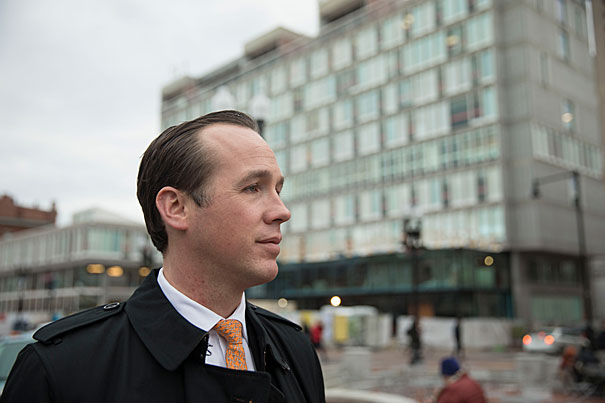
Ryan Enos talks about his new book “The Space Between Us,” in which he explores how geography shapes politics and how members of racial, ethnic, and religious groups think about each other.
Kris Snibbe/Harvard Staff Photographer
‘The Space Between Us’
New book explores the deep impact of geography on politics, psychology, behavior
Understanding geography is fundamental to understanding the world, says Ryan Enos, associate professor of government and a specialist in American politics. People often classify places or neighborhoods simply by who lives in them, he says, and build their allegiances by asking, “Are they one of us?”
In his new book “The Space Between Us,” Enos discusses the strong influence of social geography on psychology, behavior, and politics, and explains how an “us versus them” mentality can be tightly connected to a “here versus there” paradigm of place. The Gazette interviewed Enos, a specialist on race and ethnic politics, about his book and talked about what people might do to overcome the power of geography on the mind in order to increase inclusion in American cities, many of which are increasingly segregated through gentrification.
Q&A
Ryan Enos
GAZETTE: One of the main arguments of your book is that geography affects people’s behavior and their politics. Can you explain what social geography is and how it works?
ENOS: Social geography is the location of groups of people on the Earth’s surface. It’s a way to organize our world and is an important part of how we understand the world because it affects the way we perceive groups of people, how we arrange them in our minds, whether we think those groups are similar to each other or different from each other. A very prominent example that shows how social geography affects the way people vote involves how white Americans in 2008 and 2012 had to decide whether they would vote for a black man for president. I argue that one way to explain how they vote is by the influence of social geography, because they’d say, “If I’m a white person, do black people live near me?” If the answer was no, in their minds they may have subconsciously assumed that black people were different from them, and that that black man was not representative of them.
GAZETTE: You did an experiment in Boston where you found that people’s attitudes toward immigration change when you change social geography. Can you tell us more about the experiment? What were you trying to prove?
ENOS: What I tried to do was change social geography and see how that changed people’s behaviors. We sent two Spanish-speakers to Grafton and other places that are very white and asked them to stand in randomly selected train stations and speak Spanish for a few minutes every day. What we wanted to know was how people reacted to a change in social geography, and whether that affected the way they thought about politics. We surveyed people waiting for the train, who were largely upper class, liberal, and white, before and after the experiment, about their politics and attitudes on immigration. What we found was that people who were exposed to these two Spanish-speakers — who weren’t doing anything unusual, just speaking Spanish, spending a few minutes on the train station every day — changed their attitudes toward immigration. They became sharply exclusionary, and they said they wanted to keep immigrants out of the country. The experiment was completely random, nothing else changed, and it was the mere presence of these other people, this change in social geography, that changed their attitudes about politics.
GAZETTE: Did this finding surprise you?
ENOS: In some ways, I was shocked. One of the things it teaches us, and this is one of the arguments I make in the book, is that these tendencies are deeply embedded in our psychology, and that the psychological space between us increases when the geographic space between us decreases. Being residents of Massachusetts, we tend to think that anti-immigrant attitude or xenophobia is something we don’t do in this part of the country. This is not true. Anybody can be subject to these types of behaviors, and I think that is an important lesson because what it shows us is that if we want to have a harmonious society as the country continues to diversify, even places like Massachusetts need to work at it. We need to make sure we take steps as more immigrants come into a place like Massachusetts to make sure that people can get along.
GAZETTE: What are those steps? What can policymakers do?
ENOS: One point I make is that we, policymakers and the general public, don’t think about social geography when we think about integration. We actually think about integration in terms of our institutions, maybe in our schools, or sometimes in very elite institutions like universities or in certain businesses that hire a very diverse group of people. But that doesn’t touch a large segment of the population. And even if we integrate schools, because of the grasp that social geography has in our minds, if we look across our cities, and people still live in separate parts of the city, that’s going to affect how well they can relate to each other and whether they come together politically. I think that what policymakers really need to focus on is how we can build cities that are inclusive, where we not only share public spaces — which is important too — like parks and museums, but also that we share residential space. That’s a real challenge because increasingly certain parts of cities are affordable to only one type of person, and we can see this especially in places like Boston that are becoming more and more expensive. Only the wealthy, who are often a certain racial group, can live in certain parts of Boston or Cambridge. Cambridge in some ways is becoming less diverse, and one of the areas where policymakers have a big role is in whether or not they can do things about building affordable housing for a larger segment of the population, which can lead to a breakdown of segregation. Having integrated cities, not segregated cities, is an important thing for the future.
GAZETTE: You have lived in Chicago, where you worked as a high school teacher on the South Side. Between Boston and Chicago, which one is more segregated?
ENOS: Both are very segregated. Chicago by many measures is a more segregated city than Boston. But at some point cities reach a point of segregation where those distinctions become somewhat unimportant. If you ask a white person in Boston, for example, if he or she knows where to find Latinos or African-Americans, he or she can tell you easily. You see the same thing in Chicago. People know what side of the city is theirs and what side of the city belongs to another group. That’s a phenomenon in a lot of big cities all across the United States, and that’s the social geography I’m looking at. You don’t have to live in a place like Boston for very long to know that that affects our politics and that affects how we think about other people.
GAZETTE: Big cities across the United States are changing with gentrification. What’s the overall impact of gentrification on social geography?
ENOS: The danger of gentrification is that it can resegregate our cities. In some ways, our society has made a long, slow progress toward breaking down segregation from its height 50 years ago, and there is a real fear that, as cities gentrify, we will essentially revert to the segregation we had once upon a time. Segregation once was a phenomenon where you had people of color living in the inner cities and white people living in the suburbs, and that may reverse with gentrification, where you have poor people of color being moved out of the cities and white people living in the cities. And that can really lead to a problem that may be even worse than the previous problem, because people in the suburbs are a lot easier to forget. People go to the cities to work and to take part in institutions like sporting events, shopping, etc., and don’t want to go to the suburbs, so we can imagine a pattern of reverse segregation, as you may call it, that may happen because of gentrification.
GAZETTE: In your book, you also analyze Phoenix and Tucson, two cities that have dealt with immigration but have different attitudes toward immigrants. Can you explain the role of social geography in the different outcomes? Why is Phoenix more against immigrants, and Tucson largely in favor?
ENOS: One of the key factors is the level of integration, whether people are segregated or integrated across space. In Arizona, 30 percent of the population is Hispanic. In Tucson, you have people who have largely lived together for generations, Anglos and Hispanics, in a more integrated way. In Phoenix, people live in the same metro area, but Anglos and Hispanics are very divided from each other, and the presence of groups that are large and segregated is the worst possible situation for social geography. That is what leads people to think that those groups are very separate and have nothing in common, and that ultimately affects their political behavior in a way that makes them confrontational and at odds with each other. In my book, I try to imagine a scenario where the rest of Arizona would be more like Tucson, where these groups, over generations, have learned to live together, so that, in this scenario, the 30 percent Hispanic population might not matter to Anglos that much. But currently that’s not the way Phoenix is, and you see that reflected in Phoenix politics — with Sheriff Joe Arpaio, who had all these viciously anti-immigrant policies and had the support of the Anglo population in Phoenix. I argue that a big part of this is enabled by segregation.
GAZETTE: You said that the outcome of the 2016 presidential election can be explained by social geography and that Donald Trump’s rhetoric shows the powerful influence of social geography. Can you elaborate?
ENOS: We know there were Democrats who voted for Trump. Some of the places where we saw this were the places where we saw the biggest changes in social geography. If you look across the United States and you look in counties that had experienced, in the last 15 years or so, rapid growth of the Latino population, we see that those were the places where voters, even Democratic voters, who previously voted for Barack Obama, switched to Trump. We can’t know for sure, but my argument is that this looks a lot like the experiment in Boston. And perhaps what happened was that when that social geography changed, those voters became more threatened by those immigrants, and that affected the way they voted, causing them to vote for Trump. Trump became an attractive candidate to them because of the anti-migrant rhetoric he was promoting.
GAZETTE: What would you like readers to take away from your book?
ENOS: The main takeaway is that the way social geography, the way that we’re arranged out in space in our cities and our counties, affects what we think about other people. And because it affects what we think about other people, it subsequently affects our politics and whether we can be a harmonious society.
We need to think about two things. One is the public policy for changing social geography and living in a more inclusive society, and the other involves our own personal behavior, whether we can reach across that social geography and have contact with people who are different from us and learn about those people, allowing us to overcome the power that social geography has over our minds.
This interview has been edited for length and clarity.




